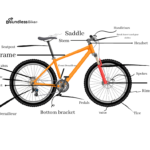Do you ever wonder whether the size of your bike frame affects your speed? As a cyclist, it’s natural to want to improve your performance and maximize the benefits of every ride. While there are many factors that contribute to how fast you can go on a bike, one question remains: does bike frame size play a role in determining your speed? In this blog post, we’ll explore the relationship between these two variables and help you understand how they impact each other. So grab your helmet and let’s dive into this topic!
What is the relationship between bike frame size and speed?
The relationship between bike frame size and speed is often a topic of debate among cyclists. While some argue that a larger frame can provide better stability at high speeds, others claim that a smaller frame offers more aerodynamic advantages.
At the core of this debate lies the concept of bike fit – finding the right balance between comfort, power transfer, and efficiency. A well-fitted bike will allow you to produce maximum power with minimum effort, resulting in increased speed and performance.
However, it’s important to note that there is no one-size-fits-all approach when it comes to bike frame size. Factors such as your height, weight, riding style and personal preferences can all impact your ideal frame size.
Does bike frame size affect speed?

Bike frame size is an important factor when choosing a bike, but does it affect your speed? The answer is yes and no. Let’s break it down.
Firstly, if the bike frame is too small or too big for you, it can affect your posture and comfort. This can result in fatigue and make you slower over long distances. On the other hand, if you have a properly fitted bike frame that suits your body size and type of riding style, then you will be able to ride more efficiently which can translate into faster speeds.
Secondly, lighter frames tend to be faster as they reduce the overall weight of the bike. However, keep in mind that lighter doesn’t always mean better as durability can also become an issue with extremely lightweight frames.
Thirdly, the material used for making the bike frame also plays a role in speed. Carbon fibre frames are generally considered to be faster due to their stiffness which allows for more power transfer from pedaling to forward motion.
How does bike frame size affect speed?

Bike frame size is one of the most critical factors that can affect your speed on a bike. The right fit and size ensure that you have an efficient transfer of power from your legs to the pedals, allowing you to ride faster with ease. But how exactly does bike frame size impact speed?
Firstly, if your bike’s frame is too large or small for you, it can negatively affect your riding position and comfort level. A poor fit can create unnecessary pressure on certain parts of your body like hands, wrists, knees or back which will cause discomforts during long rides.
Another factor affecting speed is aerodynamics. Generally speaking, smaller frames allow riders to assume more aggressive positions that reduce drag and increase their overall speed because they present less wind resistance.
On the other hand, larger frames tend to be heavier than smaller ones as those bikes need extra material to compensate for added height and length making them slower than others. Bigger bikes are also harder to maneuver due to the increased weight and longer wheelbase so they might not always perform as well in tight corners or technical sections.
Conclusion
To conclude, the bike frame size does have an impact on your speed, but it’s not the only factor that determines how fast you can go. Other factors like aerodynamics, body position and riding style also play a significant role in determining your speed.
If you’re looking for a faster ride or trying to set a new personal record, choosing the right bike frame size is definitely worth considering. A properly sized bike will help you achieve greater power transfer and more efficient pedaling which ultimately leads to better performance.
However, keep in mind that finding the right fit should be your top priority when selecting a bike frame size. It’s important to choose a comfortable and safe ride first before worrying about speed. So take time to test out different sizes and find what works best for you.
Also Read How Bike Frames Are Built: 5 Steps






